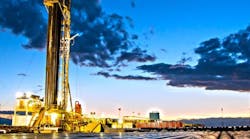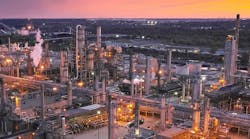Richard A. Harnett
Consulting geologist
Tulsa
The Niobrara formation in the central Rocky Mountain region has been written about at length by several authors, most recently concerning Silo field near Cheyenne, Wyo.
The Niobrara has proven an enigma to many explorationists, because while the promise is great (individual wells with cumulative production in excess of 1 million bbl), many times the results have been disappointing.
What follow are a few observations and concepts that may help start exploration on the right track.
NIOBRARA OIL
The Niobrara in most of Wyoming and Colorado is a limey shale or shaley lime with a great amount of organic carbon incorporated in the sediment. The lime content causes the Niobrara to be more brittle, and therefore it fractures more readily than the softer Cody/Steele/Pierre shale above or the Carlile shale below.
The area of the chalk facies east of Range 60 West is excluded from this discussion.
That the Niobrara can be an oil source has long been known. Published works from 1970 forward have detailed the requirements for oil generation. The short Niobrara list is Type II kerogen, 150 F. minimum, 10 million years for the onset of oil generation.
For every 18 F. of additional heat, the reaction rate roughly doubles. Temperatures above 195 F. start thermal cracking of the oil.
One of the more interesting observations is that at the moment of conversion of a kerogen bleb to oil, there is a strong pressure increase sufficient to raise the column of overlying rock, circa 1.0 psi/ft of burial.
If the cooking reaches the thermal cracking phase, there is another strong pressure increase, which accounts for most of the overpressuring found in the deeper parts of basins. Important overpressure work has been reported by Powley, Al-Shaieb et al., Barker, Hunt, by research done for the Gas Research Institute, and others.
Momper and Williams have mapped and published where the Niobrara is generating oil in the Powder River basin of Wyoming. Heat flow in the basin averages 1.4-1.6 F./100 ft of burial.
Rough approximations of the major generating area can be made using 8,500 ft of overburden. Most of that overburden has been there since Eocene.
Similar numbers can be used in the Denver basin, except that the average annual surface temperature may be slightly higher.
Similar results would be expected in the Wind River, Red Desert, Washakie, and Uinta basins. North Park and the Sand Wash basins have late Tertiary intrusives that may have created local hotspots.
The Niobrara oil has formed in these warm basin deeps, but all of the significant economic production has been from far shallower, non-generating depths. The economically recovered oil has moved out of the deeps and been produced on the basin margins.
MAJOR FIELDS
The list of these major economic producing areas is not long for the Niobrara:
- Teapot-Salt Creek
- Loveland
- Tow Creek-Sage Creek
- Buck Peak
- Rangely.
Each of these areas is on an anticlinal flexure close to a basin axis where the organic carbon is immature (Fig. 1).
Tow Creek-Sage Creek and Buck Peak in the Sand Wash basin are near late Tertiary sills and dikes that may locally have altered some of the Niobrara carbon.
The bulk of the oil in these 2 million bbl-plus areas came up from the adjacent basin deeps. The question is how.
Don Stone published his interpretation of the central Rockies tectonic framework in 1968. Research on that framework continues, but many of the elements are known, especially the larger basement shear zones that accommodate much of the compressional translations.
In the central Rockies a conjugate set of basement shears is west-northwest left lateral and northeast right lateral.
Basement shear zones have strained and caused hairline fractures in the overlying sediments. The shear induced fractures have no naturally occurring porosity, but they area zones of comparative weakness in the sediments.
lf overpressured newly formed Niobrara oil finds one of these zones of weakness, half the job of escape to lower pressures has been done. With overpressuring the shear stressed fractures are forced open and become a conduit leading to lower pressures/shallower depths.
If the shear-stressed conduit reaches a system of tectonically opened fractures (anticlinal nose), then the oil is given up to the tectonically opened fractures that are connected to more normal pressure regimes (i.e., less than overpressured).
EXAMPLES
In the Teapot-Salt Creek area of central Wyoming, the nearby Powder River basin axis is bent by two major west-northwest left lateral basement shears (Fig. 2).
The southern basement shear extends from just north of Douglas, Wyo., to the area between the south plunge of Teapot Dome and Cole Creek anticline.
East of Cole Creek on this shear the Niobrara is at generating depths, and the new Niobrara oil is locally gathered into that shear-stressed, now overpressured conduit. The oil moves toward lower pressure/shallower depth.
The brittle Niobrara fractures caused by the Cole Creek warping are charged with oil.
The rest of the oil moves on to the tectonically opened cracks over the Teapot Dome plunge, fills up that long plunge fracture reservoir, fills Teapot Dome itself, spills across the small saddle into Salt Creek anticline, fills that large world class structure, and spills yet again over into the West Salt Creek-Smokey Gap saddle on its way to Tisdale anticline (now breached by erosion into Jurassic strata).
Oil shows and lost circulation in the Niobrara are the norm on the long Teapot Dome south plunge (Sage Spring Creek field: Dakota and Muddy strat-traps), are indicative of normal pressures and open fractures in the Niobrara.
Currently the drilling on the Teapot Dome Naval Petroleum Reserve is for Niobrara, Shannon, and Frontier objectives. In the early days at Salt Creek cable tool drillers were ordered "not to fool with shale oil unless it was more than 30 b/d."
The well that caught Harry Sinclair's interest at Teapot Dome is said to have been a Niobrara well flowing a solid stream up 12 in. casing.
Niobrara/"Steele"/"Shale" production records from the early years were often commingled with the Wall Creek (Frontier) production. The Niobrara is still producing at Teapot, Salt Creek, and Smokey Gap.
The electric log character of the Niobrara at Teapot Dome-Salt Creek is barely a wide spot in the road through a shale section (Fig. 3).
The high resistivities discussed by others at Silo may reflect where the oil generates but are not necessarily found at lesser depths where the oil currently resides.
The Loveland example is perhaps similar, but less well documented with deep drilling. The Denver basin is divided into two major deeps: one under the city of Denver, and the other just west of Cheyenne, Wyo. (Fig. 4).
Near Greeley, Colo., these two basinal deep axes are disrupted by a basement shear, that complex being called the Greeley saddle.
The basement shear heads southwest from the saddle towards Loveland anticline and shallower depths. Again, a shear-stressed conduit leads overpressured Niobrara oil from the basin deeps to tectonically opened fractures and lesser (more normal) pressures at shallower depths.
In the Sand Wash basin of northwestern Colorado the eastern part of the basin axis overlays a west-northwest left lateral basement shear near Tow Creek and Sage Creek anticlines (5 North and 6 North, 86 West to 88 West).
Tow Creek field has produced 2,997,694 bbl of oil through 1990, and one well at Sage Creek has made 591,855 bbl through 1990.
The oil has moved east-southeast from the basin deep (note there is intrusive activity nearby) along the shear-stressed conduit to Tow Creek and Sage Creek anticlines with their tectonically opened fractures.
Buck Peak is on a faulted anticline near the Sand Wash basin axis. Two wells have each produced more than 1 million bbl of oil through 1990:
The 1 Voloshin produced 1,087,517 bbl.
The 1-15 Noland produced 1,328,921 bbl.
Buck Peak field has also demonstrated production interference between Niobrara wells 2-4 miles away.
Rangely field Niobrara production, locally called Mancos, is at shallow depth and concentrated on the south side of the asymmetric anticline where the rate of change of dip is at a maximum (second derivatives. This side of the Rangely structure is immediately adjacent to the eastern limit of the Uinta basin axis.
To the east of Rangely the Piceance basin may not have been hot/deep enough to generate Niobrara oil. The tectonic dynamics of the Uinta Mountains and basin are different when compared to the ranges of the central Rockies to the east.
The Uinta basin north bounding thrust closely parallels and is on the north side of the Uinta basin axis, as drawn by Wallace Hansen. The stresses and fractures along this fault could be the conduit from the hot Uinta basin deep.
This thrust is close to the south edge of the Rangely structure. Rangely has produced 13,753,525 bbl through 1990 from Mancos, but the main pay, Pennsylvanian Weber sand, has made 749,540,804 bbl.
SILO FIELD
The above is a partial analysis of areas in which major (2 million bbl-plus) production has been established.
However, there has been considerable effort recently in an area devoid of prominent basement shears or deep probing anticlines: Silo field near Cheyenne, Wyo.
The wells at Silo tap into the Niobrara where it is currently generating thermal oil and gas. The overpressuring attendant on conversion to liquid hydrocarbon has caused fractures to form in the brittle Niobrara.
Since there is no local exit (i.e., strong shear stress or structural warp), the oil stays and the fractures remain open until the overpressuring disappears. The drilling completion scenario at Silo is now too familiar strong initial production rates decline precipitously as fractures near the borehole collapse.
If the well is then shut-in and reopened later, there is usually a second lesser flush quickly followed by another precipitous decline. Possibly if exceptionally wide spacing such as 640 acres were used and wells were produced on small chokes an economic payout might be possible.
The trick is to keep the fractures near the borehole from collapsing.
SUMMARY
The hot basin Niobrara oil generating areas can be identified.
The most productive Niobrara fields are in tectonically opened cracks on anticlines that are "plugged in" to the generating deeps by fracture conduits.
BIBLIOGRAPHY
At-Shaieb, Puckette, Ely, and Abdalla, abs. in AAPG Bull., 1991, p. 532.
Al-Shaieb and Puckette in Gas Research Institute seminar, May 1991, Stillwater, Okla.
Barker, Colin, AAPG Bull., 1991, pp. 1,254-61.
Colorado Department of Natural Resources, 1990 Oil & Gas Statistics.
Hansen, Wallace, RMAG symposium guidebook, 1986.
Hunt, J. M., AAPG Bull., 1990, pp. 112.
Mallory, J.J., RMAG Special Publication 1, 1977.
Momper, J.A., AAPG Geochemistry for Geologists, course notes, 1980.
Momper and Williams, OGJ, Dec. 10, 1979, pp. 129-134.
Powley, D., abs. in AAPG Bull., 1991, P. 656.
Stone, D.S., RMAG Mountain Geologist, 1968.
Copyright 1992 Oil & Gas Journal. All Rights Reserved.

